Selecting your Compost Structure
Selecting your compost structure is NOT as important as
youwould think. What is important is that you create compost.
Compost needs seven main requirements in
place for proper decomposition. Those factors are compost size, air,
moisture, fragment size, dry matter, green matter, and heat. Initially
though, you need to make sure that your structure provides minimum
compost size. A compost bin or pile that is too small will not
create hot enough heat for proper
organic matter decomposition.
Preference and practicality will be the real reasons for the
structure you select. If you don't have a lot of room in your garden,
you may want to use a tumbler or commercial compost bin. With more
room, you have more options, like a compost pile or a wire-based
compost bin.
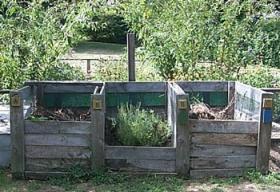
Minimum Size of Compost
Your compost structure (or compost pile) must be at a minimum
of seven cubic feet to provide enough heat, air, and moisture for
adequate decomposition. Your "finished" compost should also provide
enough compost for your garden to make your efforts worthwhile.
What's Seven Cubic Feet?
It's easy for me to tell you that the minimum size of your
compost pile should be seven cubic feet, but what does that mean?
Seven cubic feet is (simple approximates):
- Two feet wide by two feet deep by two feet high
- .5 meter wide by .5 meter feet deep by .5 meter high
- 55 gallons
- 208 liters
- 11 5-gallon buckets
- Two full large wheelbarrows
Types of Typical Compost Structures
Compost Tumbler
|
The Compost Tumbler usually has a drum type unit placed
between vertical uprights, and you manually turn the tumbler or drum.
See the lastest compost tumblers at
Amazon.com
|

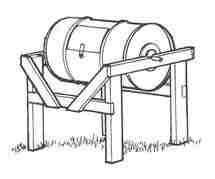
|
|
Advantages:
- Very easy to mix and turn compost materials
- Compost is very well aerated
- Excludes rodents
- Easy to move (mobile)
|
|
Disadvantages:
- The Compost Tumbler can be expensive`
- You lose contact with your native soil for
microorganisms
and earthworms exchange
|
Stackable Compost Bin
|
The Stackable Compost Bin can be made of wood or
commercial types are available.
See
the lastest composters at Amazon.com
|
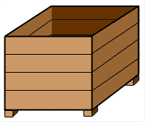
|
|
Advantages:
- Makes it easy to adapt to the size and volume of
compost
- Compost layers are well contained and easy to manage
|
|
Disadvantages:
- Need more space for unused stacks
- Many parts (stacks) to inventory
- Building complexity increases
|
Wire Mesh Compost Bin
|
Wire Mesh Compost Bins are perhaps the most versatile of
compost structures. They are easy to build and maintain.
|
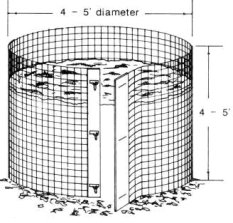
|
|
Advantages:
- Compost is very well aerated
- Easy to move (mobile)
- Rodent resistant
- Easier to work with finished compost
- Inexpensive to build
- Contact with your native soil for microorganisms and
earthworms exchange
|
|
Disadvantages:
- The wire will rust within time
|
Fixed Compost Bin
|
These types of compost structures are stationary, and
are usually located in a permanent location. Materials used are wood,
wire, blocks, or brick
|
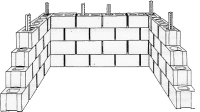
|
|
Advantages:
- Contact with your native soil for microorganisms and
earthworms exchange
- Easy to camouflage
|
|
Disadvantages:
- Not mobile
- Materials to build could be expensive
- Manual turning required for aeration
|
Multi Compost Bin
|
Multi Compost Bins work based on incrementing your
compost from one bin to the next. As the first bin's compost is filled,
and as had time to decompose, it is then turned into the second bin,
and so on into the next. Most of the finished compost will end up in
the last bin, and you can begin to use it for your garden from the
bottom of the pile.
|
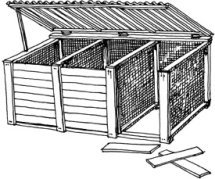
|
|
Advantages:
- Contact with your native soil for microorganisms and
earthworms exchange
- Easy to camouflage
- Easier than fixed compost bin to turn compost for
aeration
- Large quantities of compost are easier to work with
|
|
Disadvantages:
- Not mobile
- Materials to build could be expensive
- Manual turning required for aeration
- Labor intensive
|
Freestanding Compost Pile
|
Freestanding Compost Piles are convenient in that they
are easy to build and maintain. You can also add organic material as
needed.
|
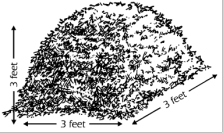
|
|
Advantages:
- Inexpensive to build
- Contact with your native soil for microorganisms and
earthworms exchange
- Little effort is need to maintain
- Compost location can be easily changed
|
|
Disadvantages:
- Easy for rodents to invade
- May appear unattractive if it is in plain view of
neighbors
|
Once your compost structure is selected you can now learn how
to make compost.
See the latest compost products at
Amazon.com 
Next - learn how to create your compost
Return to the top of Selecting your Compost Structure
Enjoy this page? Please pay it forward. Here's how...
Would you prefer to share this page with others by linking to it?
- Click on the HTML link code below.
- Copy and paste it, adding a note of your own, into your blog, a Web page, forums, a blog comment,
your Facebook account, or anywhere that someone would find this page valuable.
|







